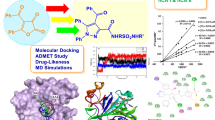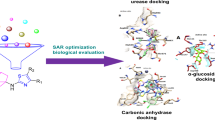Abstract
The increased cases of hyperpigmentation and other related dermatological problems in human beings have led to the development of a number of tyrosinase inhibitors. In the present study, we have used a docking algorithm to simulate binding between tyrosinase and hydroxy-substituted (Z)-3-benzylideneindolin-2-one chalcones and studied the inhibition of tyrosinase. The results of virtual screening studies indicated that the estimated free energy of binding of all the docked ligands ranged between −8.08 and −4.27 kcal/mol, while their estimated inhibition constants (Ki) were found to be between 1.20 and 736.75 µM. Among all the compounds docked, 2,4,6-trihydroxy-substituted chalcone (11) showed the lowest estimated free energy of binding followed by dihydroxy and monohydroxy-substituted analogs. In the in vitro tyrosinase inhibition assay, 11 displayed an IC50 of 46.26 µM. Moreover, in ADMET study, 11 was found to be safe and non-toxic. The present study suggested that the strategy of predicting tyrosinase inhibition based on hydroxy-substituted (Z)-3-benzylideneindolin-2-one chalcones and their orientation would be useful for develo** novel potent tyrosinase inhibitors.









Similar content being viewed by others
References
Bandgar BP, Adsul LK, Chavan HV, Shringare SN, Korbad BL, Jalde SS, Lonikar SV, Nile SH, Shirfule AL (2012) Synthesis, biological evaluation, and molecular docking of N-{3-[3-(9-methyl-9H-carbazol-3-yl)-acryloyl]-phenyl}-benzamide/amide derivatives as xanthine oxidase and tyrosinase inhibitors. Bioorg Med Chem 20:5649–5657
Chang TS (2009) An updated review of tyrosinase inhibitors. Int J Mol Sci 10:2440–2475
Cheng F, Li W, Zhou Y, Shen J, Wu Z, Liu G, Lee PW, Tang Y (2012) admetSAR: a comprehensive source and free tool for assessment of chemical ADMET properties. J Chem Inf Model 52:3099–3105
Fisher AA (1983) Current contact news. Hydroquinone uses and abnormal reactions. Cutis 31:240–244
Fujimoto N, Onodera H, Mitsumori K, Tamura T, Maruyama S, Ito A (1999) Changes in thyroid function during development of thyroid hyperplasia induced by kojic acid in F344 rats. Carcinogenesis 20:1567–1571
Gawande SS, Warangkar SC, Bandgar BP, Khobragade CN (2013) Synthesis of new heterocyclic hybrids based on pyrazole and thiazolidinone scaffolds as potent inhibitors of tyrosinase. Bioorg Med Chem 21:2772–2777
Ha YM, Kim JA, Park YJ, Park D, Kim JM, Chung KW, Lee EK, Park JY, Lee JY, Lee HJ, Yoon JH, Moon HR, Chung HY (2011) Analogs of 5-(substituted benzylidene)hydantoin as inhibitors of tyrosinase and melanin formation. Biochim Biophys Acta 1810:612–619
Ha YM, Park YJ, Kim JA, Park D, Park JY, Lee HJ, Lee JY, Moon HR, Chung HY (2012) Design and synthesis of 5-(substituted benzylidene)thiazolidine-2,4-dione derivatives as novel tyrosinase inhibitors. Eur J Med Chem 49:245–252
Iozumi K, Hoganson GE, Pennella R, Everett MA, Fuller BB (1993) Role of tyrosinase as the determinant of pigmentation in cultured human melanocytes. J Invest Dermatol 100:806–811
Jun N, Hong G, Jun K (2007) Synthesis and evaluation of 2′,4′,6′-trihydroxychalcones as a new class of tyrosinase inhibitors. Bioorg Med Chem 15:2396–2402
Kang SM, Heo SJ, Kim KN, Lee SH, Yang HM, Kim AD, Jeon YJ (2012) Molecular docking studies of a phlorotannin, dieckol isolated from Ecklonia cava with tyrosinase inhibitory activity. Bioorg Med Chem 20:311–316
Khatib S, Nerya O, Musa R, Shmuel M, Tamir S, Vaya J (2005) Chalcones as potent tyrosinase inhibitors: the importance of a 2,4-substituted resorcinol moiety. J Bioorg Med Chem 13:433–441
Lerner AB, Fitzpatrick TB, Calkins E, Summerson WH (1955) Role of tyrosinase as the determinant of pigmentation in cultured human melanocytes. J Biol Chem 187:793–802
Lipinski CA, Lombardo F, Dominy BW, Feeney PJ (2001) Experimental and computational approaches to estimate solubility and permeability in drug discovery and development settings. Adv Drug Deliv Rev 46:3–26
Mason HS (1955) Comparative biochemistry of the phenolase complex. Adv Enzymol 16:105–184
Morris GM, Huey R, Lindstrom W, Sanner MF, Belew RK, Goodsell DS, Olson AJ (2009) AutoDock4 and AutoDockTools4: Automated docking with selective receptor flexibility. J Comput Chem 30:2785–2791
Okombi S, Rival D, Bonnet S, Mariotte AM, Perrier E, Boumendjel A (2006) Discovery of benzylidenebenzofuran-3(2H)-one (aurones) as inhibitors of tyrosinase derived from human melanocytes. J Med Chem 49:329–333
Roh JS, Han JY, Kim JH, Hwang JK (2004) Inhibitory effects of active compounds isolated from safflower (Carthamus tinctorius L.) seeds for melanogenesis. Biol Pharm Bull 27:1976–1978
Seo SY, Sharma VK, Sharma N (2003) Mushroom tyrosinase: recent prospects. J Agric Food Chem 51:2837–2853
Si Y-X, Yin S-J, Park D, Chung HY, Yan L, Lü Z-R, Zhou H-M, Yang J-M, Qian G-Y, Park Y-D (2011) Tyrosinase inhibition by isophthalic acid: kinetics and computational simulation. J Biol Macromol 48:700–704
Solano F, Briganti S, Picardo M, Ghanem G (2006) Hypopigmenting agents: an updated review on biological, chemical and clinical aspects. Pigment Cell Res 19:550–571
Author information
Authors and Affiliations
Corresponding author
Additional information
Sharad Kumar Suthar, and Vaibhav Aggarwal authors hold an equal contribution.
Electronic supplementary material
Below is the link to the electronic supplementary material.
Rights and permissions
About this article
Cite this article
Suthar, S.K., Aggarwal, V., Chauhan, M. et al. Molecular docking and biological evaluation of hydroxy-substituted (Z)-3-benzylideneindolin-2-one chalcones for the lead identification as tyrosinase inhibitors. Med Chem Res 24, 1331–1341 (2015). https://doi.org/10.1007/s00044-014-1225-4
Received:
Accepted:
Published:
Issue Date:
DOI: https://doi.org/10.1007/s00044-014-1225-4




